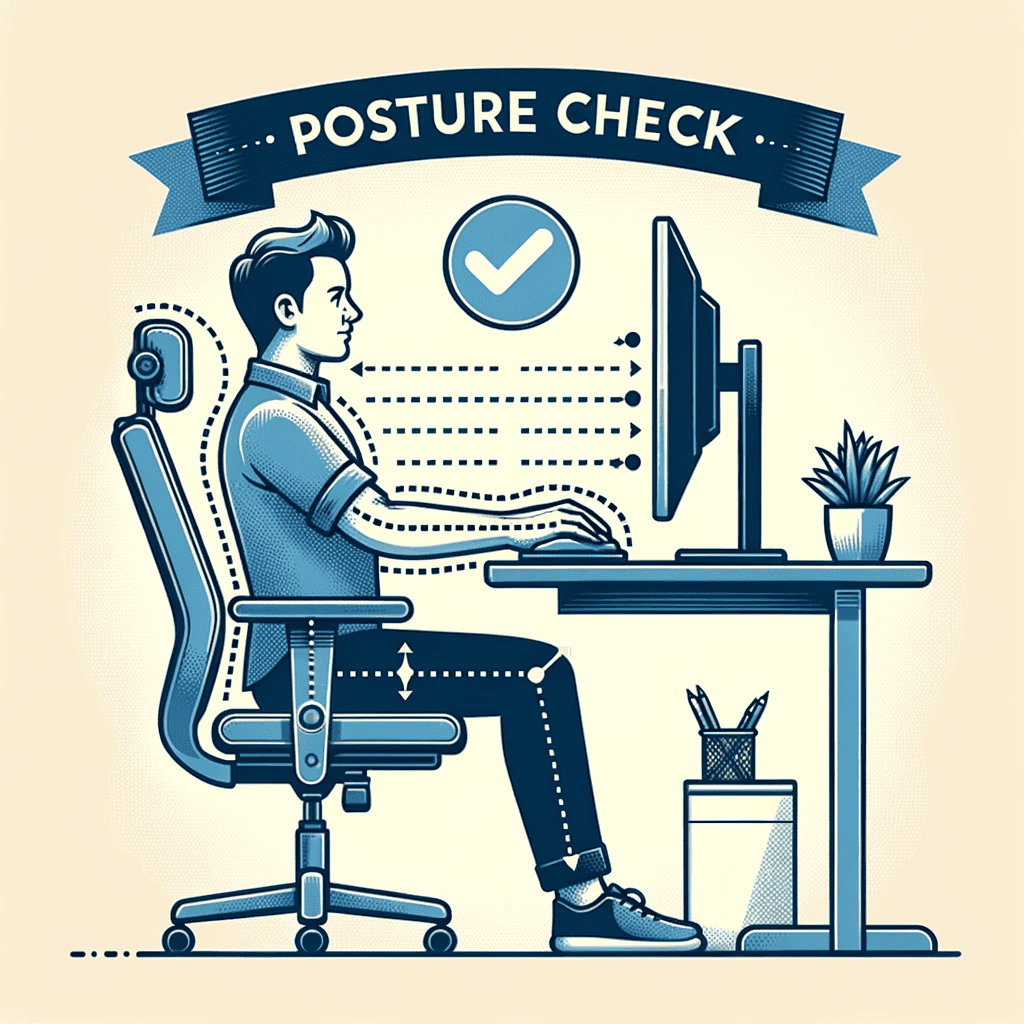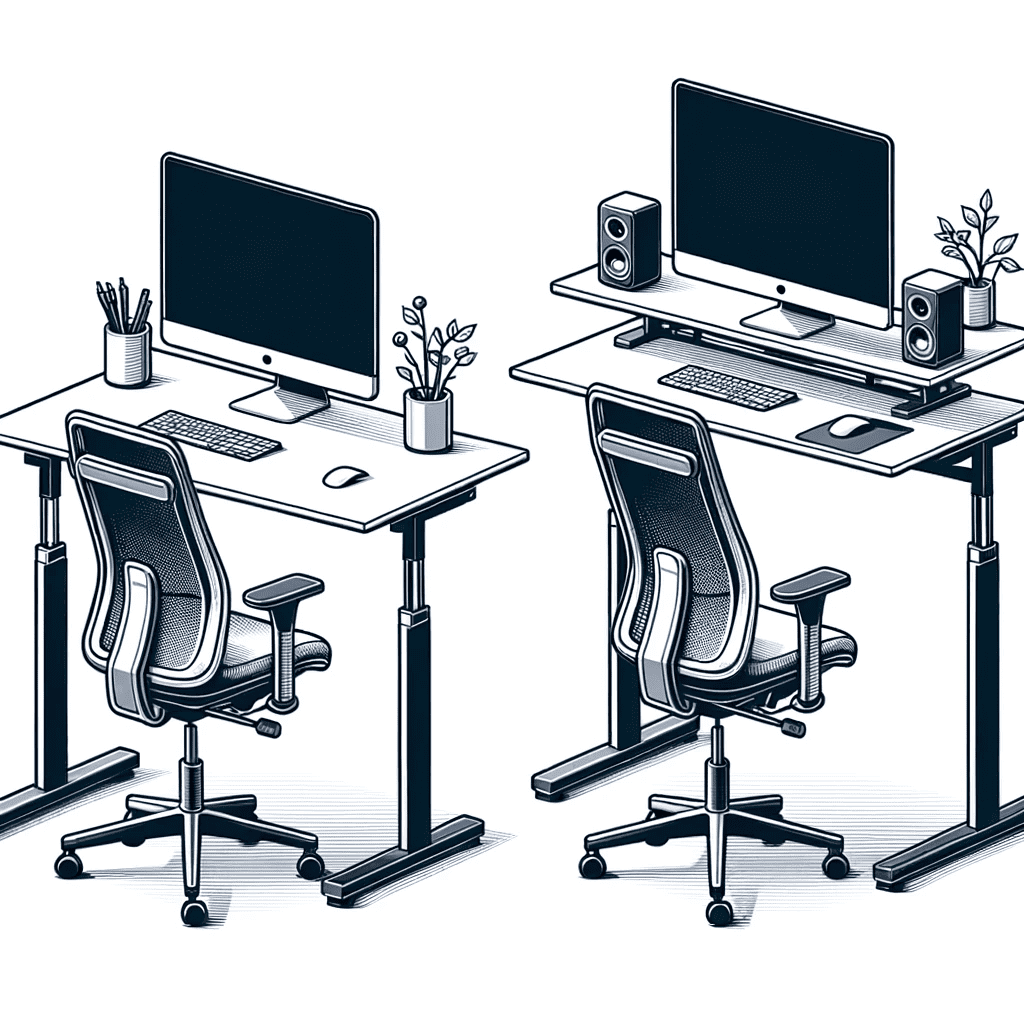Ergonomics is more than just a buzzword in the modern workplace; it’s a holistic science that delves into creating harmony between people and their working environment. By optimizing this relationship, we can reduce health risks, increase productivity, and enhance the overall quality of life.
In this article, we explore deeper ergonomics, offering insights into setting up an optimal workstation, highlighting essential ergonomic tools and accessories, and emphasizing the comprehensive importance and relation between ergonomics and carpal tunnel syndrome in our day-to-day lives.
Ergonomics and Carpal Tunnel Syndrome
Here is how you can prevent carpal tunnel syndrome by improving your workspace:
Setting Up an Ergonomic Workstation
Crafting an ergonomic workstation goes beyond mere furniture placement. It’s about understanding human anatomy, movement, and limitations and designing the workspace accordingly. Let’s break this down further:
Chair and Posture: Reducing the Risk of Carpal Tunnel Syndrome
Carpal Tunnel Syndrome is when the median nerve, which runs from the forearm to the hand, becomes pressed or squeezed at the wrist. While many factors can contribute to its development, ensuring proper chair adjustment and maintaining good posture can play a role in its prevention.

Chair Adjustment: More Than Just Comfort
1. Spinal Support: An ergonomic chair that supports the spine’s natural curvature can prevent lower back issues [1]. But how does this relate to CTS?
- Balanced Upper Body: A supported spine ensures that the upper body, including the shoulders and arms, is in a neutral and balanced position. This balance reduces the strain on the arms and wrists when performing tasks like typing.
2. Adjustable Armrests: Proper arm positioning can reduce the risk of developing conditions like CTS [2]. Here’s how adjustable armrests come into play:
- Shoulder Positioning: Keeping the shoulders relaxed with the help of armrests ensures that there isn’t undue tension traveling down to the wrists. Tense shoulders can lead to cramped wrists, potentially exacerbating CTS symptoms.
- Neutral Wrist Position: With the help of adjustable armrests, one can maintain a wrist position that’s neither flexed nor overextended. This neutral position is vital to prevent added pressure on the median nerve at the wrist.
Posture Check: An Indirect Shield Against CTS
1. The Perils of Slouching:
Slouching isn’t just bad for the spine; it can indirectly affect the wrists. Get chiropractic care in Issaquah WA
- Wrist Alignment: A slouched posture can lead to misalignment of the wrist. When we slouch, our shoulders roll forward, leading our wrists to adopt awkward angles, especially when typing or using a mouse. This misalignment can place additional pressure on the wrist’s median nerve.

2. The Ideal Alignment:
- Head & Shoulder Position: Ensuring that your head is level, facing forward and that your shoulders are relaxed but not slumped can create a chain of proper alignment down to the wrists. When the upper body is well-aligned, it becomes easier to maintain a neutral wrist position, thus reducing the risk of conditions like CTS.
Desk Configuration & Monitor Position: Minimizing Carpal Tunnel Risk
Carpal Tunnel Syndrome is predominantly associated with wrist and hand strain, often exacerbated by repetitive movements or improper ergonomics [3]. While the syndrome specifically affects the wrist, the setup of your workspace, including your desk configuration and monitor position, can indirectly influence the condition.
Desk Configuration: More Than Just Aesthetic Appeal
1. Desk Depth:
- Wrist Positioning: A deeper desk offers more room for the monitor and the keyboard [4]. This allows users to set their keyboards at a distance where they can comfortably rest their wrists and hands in a straight line, minimizing the risk of bending the wrist excessively. Keeping the wrist in a neutral position is crucial for preventing undue pressure on the median nerve, which can lead to or exacerbate CTS symptoms.

2. Cable Management:
- Safe Movement: Cluttered cables can force users to adopt awkward postures or movements when accessing different parts of their desks. Overreaching or stretching because of cable obstructions can strain the wrist and hand muscles, increasing the risk of conditions like CTS.
- Mental Clarity: Beyond the physical risks, a clutter-free environment promotes mental clarity and focus. A more organized workspace can reduce the chances of making ergonomic mistakes, such as positioning the mouse too far away and subsequently overextending the wrist.
Monitor Position: Direct Impact on Upper Body Alignment
- Neck and Shoulder Strain: Adjusting the monitor to reduce reflections and glare means less need to lean forward or tilt the head. When the head and neck are in a neutral position, it positively affects the alignment of the shoulders and, by extension, the wrists. Any strain on the neck and shoulders can indirectly lead to wrist strain, especially during tasks that involve repetitive wrist movements, like typing.
- Eyes to Wrist Coordination: Ensuring the monitor is perpendicular to your line of sight also ensures that you aren’t reaching out or pulling back your hands inconsistently due to visual misjudgments. Such misalignments can contribute to repetitive strain injuries, including Carpal Tunnel Syndrome.
Keyboard and Mouse Placement: A Catalyst for Wrist Alignment
- Promoting Neutral Wrist Posture: Tilting the keyboard slightly can help users maintain a straight or neutral wrist position. This posture reduces the risk of the median nerve getting pinched or compressed within the carpal tunnel [5]. When keyboards are flat or tilted away from the user, it may encourage wrist extension (bending upwards) which can add pressure on the carpal tunnel.
- Balancing Force Distribution: A slight tilt can allow even force distribution across all fingers while typing. This minimizes over-reliance on specific fingers or wrist areas, which could otherwise aggravate or accelerate CTS symptoms.

Mouse Placement: The Unsung Hero in CTS Prevention
- Reducing Lateral Wrist Bending: Placing the mouse too far to the side or away from the user may cause one to reach out, leading to the wrist bending laterally (side-to-side). This deviation can strain the wrist’s tendons and ligaments, potentially increasing the pressure inside the carpal tunnel. By keeping the mouse close, one ensures that the wrist remains in a neutral, straight position, reducing the chances of median nerve compression.
- Ensuring Relaxed Shoulder and Arm Position: When the mouse is positioned within close reach, the shoulders and upper arm can remain relaxed and close to the body. This prevents unnecessary tension in the shoulders and arms, which can indirectly influence wrist positioning and exacerbate CTS risk factors.
Ergonomic Tools and Accessories
Ergonomic tools and accessories are designed to maximize productivity by reducing user fatigue and discomfort. From chairs with lumbar support to keyboards that alleviate wrist strain, these tools play a pivotal role in creating a workspace that caters to an individual’s physical needs. Not only do they help prevent a host of musculoskeletal issues, but they also contribute to improved efficiency and job satisfaction. Investing in such tools is a testament to the adage, “Prevention is better than cure,” ensuring that one’s work environment promotes health and well-being.
The Advantages of Sit-Stand Desks: Reducing Prolonged Sitting Risks
Modern workspaces have evolved considerably in response to the growing body of research highlighting the adverse effects of prolonged sitting [6]. One innovative solution that has emerged to address this is the sit-stand desk. These desks provide users with the flexibility to adjust their working height, enabling them to transition between sitting and standing postures throughout their workday. Here’s an exploration into the benefits and functionality of sit-stand desks:
Flexibility in Work Posture
1. Transitioning with Ease: Sit-stand desks are designed to allow for smooth transitions between sitting and standing positions. With either manual adjustments or electric mechanisms, users can find their optimal height setting for both postures.
2. Catering to Individual Needs: Everyone has a unique body structure and comfort level. These desks can be customized to cater to different heights and preferences, ensuring ergonomic alignment for each user.

Health Benefits of Alternating Postures
1. Reduction in Musculoskeletal Strain: Constant sitting can strain various body parts, including the lower back, neck, and shoulders. By allowing the option to stand, these desks help distribute the physical load and reduce concentrated pressure on specific body areas.
2. Prevention of Stagnation: Standing encourages slight movements, such as shifting weight from one leg to another. These subtle motions can help in reducing the risk of blood pooling in the legs, which can lead to conditions like deep vein thrombosis.
3. Boosting Energy and Productivity: Several studies have suggested that alternating between sitting and standing can enhance alertness and productivity. Standing can help improve circulation, which may lead to better oxygen supply to the brain, thereby enhancing cognitive functions.
Mitigating the Risks of Prolonged Sitting
1. Cardiovascular Health: Prolonged sitting has been linked to various cardiovascular diseases. By standing intermittently, one can potentially reduce the risk of heart-related ailments.
2. Metabolic Improvements: Standing burns more calories than sitting. Regular transitions can, therefore aid in weight management and can have positive effects on metabolic rates.
3. Lowering Risk of Chronic Diseases: Extended periods of sitting have been associated with an increased risk of diseases like diabetes and certain types of cancer. By breaking the sitting pattern, one might lower these associated risks.
Task Lighting
Importance for Carpal Tunnel Prevention
While task lighting might seem unrelated to Carpal Tunnel Syndrome at first glance, its relevance emerges when considering ergonomics. Inadequate lighting can inadvertently promote poor postures. For example, if you’re straining to see keys on a keyboard or documents due to poor lighting, you might lean forward or position your hands awkwardly. Over time, these compensatory postures can increase the strain on the wrist, making conditions ripe for disorders like Carpal Tunnel.
Ensuring Optimal Illumination
Adjustable task lighting provides the advantage of directing light precisely where it’s needed, preventing the need for such compensatory postures. By ensuring that your workspace is well-lit, you can work comfortably without straining your eyes or adjusting your posture in ways that might stress your wrists.
Avoiding Screen Glare
Another ergonomic concern is screen glare, which can not only strain the eyes but also lead to leaning into screens or adjusting hand positions to see better. Proper task lighting can be adjusted to avoid direct light on screens, mitigating glare and allowing for a neutral wrist and hand posture while working.
The Importance of Ergonomics in Daily Life
While offices are the primary focus for ergonomics, its principles extend to almost all facets of our daily routines.
- Preventing Musculoskeletal Disorders: Ergonomics directly impacts our musculoskeletal health. For instance, a poorly set up workstation can lead to chronic disorders like carpal tunnel syndrome, where the median nerve is compressed at the wrist, leading to pain, numbness, and other symptoms. Tendonitis, a condition where the cords connecting muscles to bones become inflamed, is another disorder stemming from repetitive strains. By understanding ergonomics, we can rearrange our environments to minimize these risks.
- Enhancing Productivity: A comfortable worker is undoubtedly a more productive one. Discomfort leads to frequent breaks and reduced concentration. With an ergonomic setup, one can work longer with consistent efficiency.
- Daily Tasks & Ergonomics: Even mundane tasks like cooking can benefit from ergonomics. For instance, padded hand tools can reduce the risk of strain injuries. Similarly, when watching TV, placing the screen at eye level can prevent neck strain.
Conclusion
At Eastside Ideal Health, our team of skilled chiropractors specializes in providing effective treatment for carpal tunnel syndrome. We are committed to delivering personalized care to alleviate your symptoms and improve your hand function. Trust our expertise for your path to recovery.

